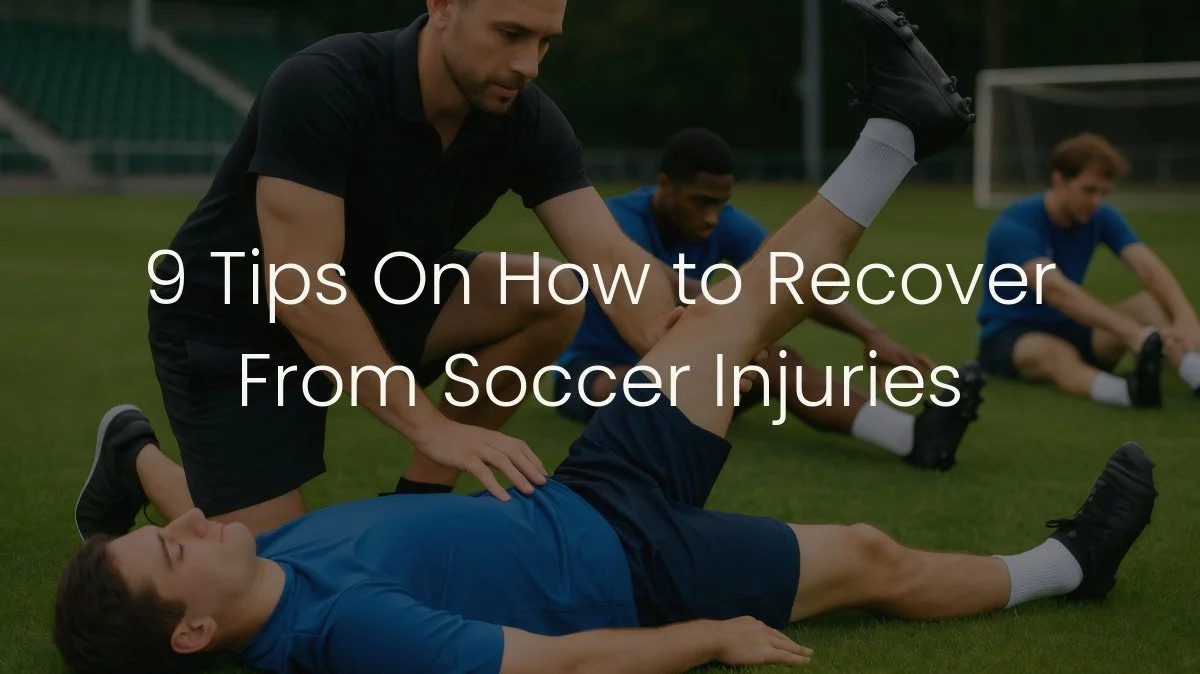9 Tips On How To Recover From Soccer Injuries
Guest Post by: Daniel Pena
While most injured soccer players are sitting on the couch hoping for the best, smart players know that in order to come back from recovery faster and stronger, they need a strategic treatment plan that targets both the physical and mental aspects of healing.
The difference between a quick recovery and being out for months usually comes down to the actions players take immediately after the injury and the consistency with which they follow the right recovery strategies.
Soccer injuries are one of the worst parts of the game because you are not able to do what you love, whether that is training with your team, competing in matches, or simply enjoying pickup games with friends. However, with the right approach and mindset, this challenging period can become an opportunity to address weaknesses, build mental resilience, and return to the field as a more complete player than before.
In this guide, I will go over 9 tips to help you recover from general soccer injuries faster, avoid common mistakes that lead to re-injury, and maximize your chances of returning to optimal performance as quickly and safely as possible. Just as important as it is to know how to recover from an injury is knowing how to train to prevent those common injuries in the first place.
How do you enhance recovery as an injured soccer player?
The biggest mistake injured soccer players make is treating recovery as passive waiting instead of active preparation for their comeback. Professional athletes and elite athletes in general understand that time is valuable, and even if you're injured, there are many things you can be working on instead of sitting still and calling that optimal recovery.
The nine strategies below can transform your injury period from lost time into a competitive advantage that prepares your mind and body for peak performance once you're able to return to the playing field.
Tip 1: Based on the Injury, Seek Immediate Professional Medical Help
When players experience an injury, depending on the type and severity of that injury, it is important to seek immediate professional medical help. A professional assessment through imaging tests like X-rays or MRIs helps identify hidden issues in the injury to determine the most effective recovery strategies for that specific injury.
Tip 2: Follow a Proper Athletic Development and Injury Prevention Program
Once you know exactly what the injury is, it is important to work with a qualified professional to develop a specific physical therapy rehab program. This approach should progress through distinct phases, from initial healing and pain management to strength building and sport-specific movement training, while incorporating injury prevention strategies to reduce the risk of future problems.
Tip 3: Address Mental Health and Mindset
Real recovery involves both physical and mental healing, and feeling frustrated during the start of the recovery process is normal for soccer players to experience. However, developing healthy coping strategies like visualization techniques, setting realistic recovery timelines, and building strong support systems with teammates, family, and professionals can help you maintain positivity and motivation throughout the healing process.
Tip 4: Prioritize Quality Sleep and Rest
High-quality sleep is your best friend when it comes to proper recovery. Sleep is when your body releases growth hormones that directly support tissue repair and muscle recovery, and maintaining healthy circadian rhythms through consistent sleep schedules helps optimize the natural healing processes.
Tip 5: Focus on Proper Nutrition and Hydration for Healing
Food is also your best friend when it comes to proper recovery because the food you eat will either speed up or slow down the healing process. Focus on eating fresh, local, in-season, organic, nutrient-dense whole foods that are minimally processed, and that provide your body with the essential nutrients it needs to recover properly.
Also, prioritize your hydration because it is just as important as your nutrition for maintaining optimal blood flow, nutrient transport, and waste product removal throughout the recovery process.
Tip 6: Protect yourself from NNEMF and surround yourself with NEMFs
Non-Native EMFs, or man-made EMFs, are forms of electromagnetic frequencies that we cannot see, but interact with our body and mitochondria in ways that may disrupt cellular function and recovery processes. On the other hand, surrounding yourself with Native EMFs, such as sunlight and the Schumann resonance, by spending time grounded in nature, can have a positive effect on your mitochondria and the recovery process.
Tip 7: Participate in Light Active Recovery Strategies
Active recovery involving light physical activities like walking, light cross-training with other sports, and gentle movements help improve blood flow and circulation while reducing muscle soreness and stiffness during the recovery process. Active recovery, which is usually recommended by physical therapists and sports medicine professionals, supports recovery by promoting waste product removal and maintaining mobility without adding too much stress that could actually increase injury risk.
Tip 8: Use Reliable Recovery Methods
The best recovery methods besides the ones mentioned above, such as sleep, nutrition, hydration, EMF exposure, and active recovery, include hot therapy, cold therapy, red light therapy, sauna, and massage therapy. These evidence-based recovery strategies help reduce inflammation, provide pain relief, and improve blood flow while supporting the recovery process for soccer players dealing with muscle strains, ankle sprains, or other common injuries.
Tip 9: Use The Right Soccer Protection Gear
Finally, using the right training gear and equipment is a crucial injury prevention strategy that a lot of soccer players often overlook, especially when returning from injuries like ankle sprains, muscle strains, or leg injuries. Quality protective gear includes items such as shin guards, the right type of footwear, and certain ankle or knee braces that can provide players with temporary essential support.
The right protective gear is crucial, but remember it is important not to rely on a brace as a permanent solution, and instead focus on the root cause of the injury, not the symptoms.

